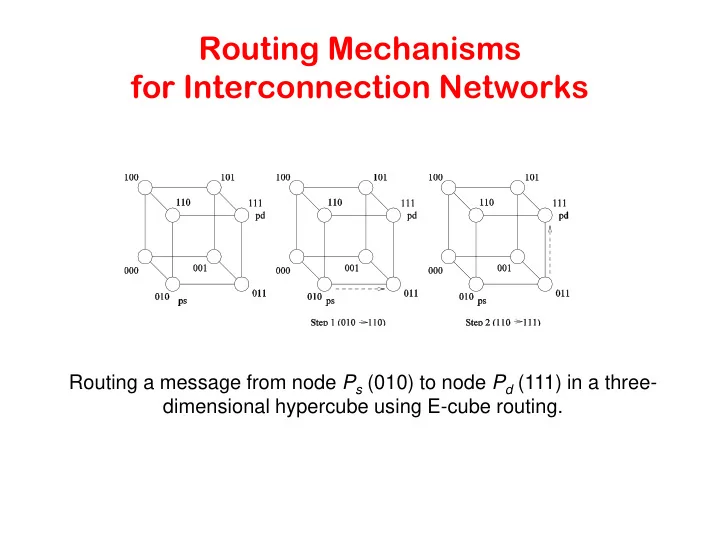

Routing Mechanisms for Interconnection Networks Routing a message from node P s (010) to node P d (111) in a three- dimensional hypercube using E-cube routing.
Mapping Techniques for Graphs • Often, we need to embed a known communication pattern into a given interconnection topology. • We may have an algorithm designed for one network, which we are porting to another topology. For these reasons, it is useful to understand mapping between graphs.
Mapping Techniques for Graphs: Metrics • When mapping a graph G(V,E) into G’(V’,E’), the following metrics are important: • The maximum number of edges mapped onto any edge in E’ is called the congestion of the mapping. • The maximum number of links in E’ that any edge in E is • mapped onto is called the dilation of the mapping. • The ratio of the number of nodes in the set V’ to that in set V is called the expansion of the mapping.
Embedding a Linear Array into a Hypercube • A linear array (or a ring) composed of 2 d nodes (labeled 0 through 2 d − 1) can be embedded into a d -dimensional hypercube by mapping node i of the linear array onto node • G(i, d) of the hypercube. The function G(i, x) is defined as follows: 0
Embedding a Linear Array into a Hypercube The function G is called the binary reflected Gray code (RGC). Since adjoining entries ( G(i, d) and G(i + 1, d) ) differ from each other at only one bit position, corresponding processors are mapped to neighbors in a hypercube. Therefore, the congestion, dilation, and expansion of the mapping are all 1.
Embedding a Linear Array into a Hypercube: Example ( a) A three-bit reflected Gray code ring; and (b) its embedding into a three-dimensional hypercube.
Embedding a Mesh into a Hypercube • A 2 r × 2 s wraparound mesh can be mapped to a 2 r + s - node hypercube by mapping node (i, j) of the mesh onto node G(i, r − 1 ) || G(j, s − 1) of the hypercube (where || denotes concatenation of the two Gray codes).
Embedding a Mesh into a Hypercube (a) A 4 × 4 mesh illustrating the mapping of mesh nodes to the nodes in a four-dimensional hypercube; and (b) a 2 × 4 mesh embedded into a three-dimensional hypercube. Once again, the congestion, dilation, and expansion of the mapping is 1.
Embedding a Mesh into a Linear Array • Since a mesh has more edges than a linear array, we will not have an optimal congestion/dilation mapping. • We first examine the mapping of a linear array into a mesh and then invert this mapping. • This gives us an optimal mapping (in terms of congestion).
Embedding a Mesh into a Linear Array: Example (a) Embedding a 16 node linear array into a 2-D mesh; and (b) the inverse of the mapping. Solid lines correspond to links in the linear array and normal lines to links in the mesh.
Embedding a Hypercube into a 2-D Mesh • Each node subcube of the hypercube is mapped to a node row of the mesh. • This is done by inverting the linear-array to hypercube mapping. • This can be shown to be an optimal mapping.
Embedding a Hypercube into a 2-D Mesh: Example Embedding a hypercube into a 2-D mesh.
Recommend
More recommend